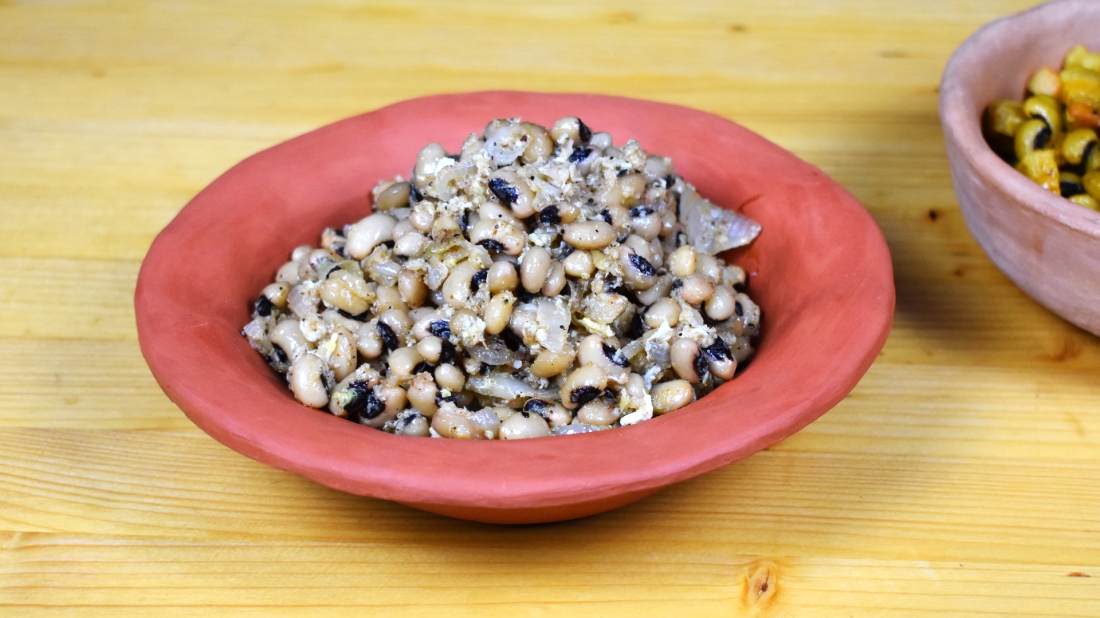In the ancient and medieval Italian sources, there are a few recipes with faseoli/fasseoli (Latin) or fasoli (Italian), words usually translated into English as beans. Bean is a quite generic term that frequently refers to legumes classified in the genus phaseolus which come from the New World. Indeed, to prepare ancient Roman and medieval recipes, it is necessary to identify the legume that was used before the discovery of America. Luckily, Renaissance authors (for example Mattioli and Felici) describe in detail the local varieties in contrast with the newly-imported species, called fagioli or fagiuoli turcheschi (Turkish beans).
The kinds of beans cultivated in Italy belong to the genus vigna. Medieval authors frequently write about two varieties, one white and the other red. The white one, described by the Renaissance authors, is now called black-eyed peas, and it is the one we are using for the two recipes we are preparing today, simple and extraordinarily tasty: the first with onions, eggs, and cheese; the second with saffron and bacon.
We selected these recipes from the Liber de Coquina, an anonymous cookbook written in Latin at the end of the 13th century. Below, you will find the original sources with our translation into English, a note about the text and the ingredients, and the video of the recipes with captions in English and Italian. Enjoy!
Preparation of the black-eyed peas
Steep the black-eyed peas in water for about six hours. Discard the water and boil the beans for about 40 minutes, then strain them.
For both recipes, we used 200 grams of dry black-eyed peas.
BEANS WITH ONION AND CHEESE
Ingredients
precooked black-eyed peas
1 egg
1 onion
aged pecorino or Parmigiano
olive oil
spices (black pepper, nutmeg, cloves)
Method
Grind in the mortar black pepper, nutmeg, and cloves. Slice the onion, grate the cheese, and beat the egg.
Pour in a pan olive oil and fry the onion until it is soft and golden. Add the precooked black-eyed peas and the spices, cooking for a few minutes.
Add the egg and cheese, stirring for a few seconds, and remove from the fire. Plate and serve still hot.
Note about the ingredients
The anonymous author does not specify what kind of spices to use. We chose a mix of strong spices, but you can use others among the ones at disposal of the cook during the Middle Ages, for example, ginger, cinnamon, Indian bay leaves, long or white pepper, and others.
Pecorino and Parmigiano were among the most used hard cheeses in the Middle Ages. The latter is described in detail in a treatise about dairy products written by Pantaleone da Confienza and mentioned also in Giovanni Boccaccio’s Decameron. We suggest aged pecorino, because the pairing with black-eyed peas is great.
Original text
De fasseolis: fasseolos perbullitos lotos pone ad ignem ad coquendum cum oleo et cipola et bonis speciebus et caseo grattato et ouis batutis.
Translation
About beans: cook parboiled beans without their hulls adding oil, onion, good spices, grated cheese, and beaten eggs.
BEANS AND BACON
Ingredients
precooked black-eyed peas
smoked pancetta or bacon
saffron
long pepper
Method
Soak the saffron in warm water and grind the long pepper in the mortar. Slice the pancetta or bacon, then cook it until it renders. Add the precooked black-eyed peas, the saffron, and the long pepper. Cook until the water dries, then plate and serve still hot.
Note
The author writes that this recipe is typical of the March of Treviso, a city in North-East Italy.
Saffron was one of the most common spices in the Middle Ages and Renaissance. It was particularly appreciated not only for its flavor, but also for its beautiful color. We wrote in detail about the medical and culinary sources in a previous article.
Long pepper was the most prized variety of pepper used in Italy since the Antiquity. Is was more costly than black and white pepper. The author does not write what kind of pepper to use, so you can choose the one you prefer according to your taste.
We chose smoked pancetta for this recipe, but the word used by the author, caro salsata, refers to any kind of cured pork meat. Smoking and salting were the main methods traditionally used to preserve fish and meat (usually pork) since the Antiquity, as described with detailed recipes by Cato and Columella.
Original text
Ad usum Marchie triuisine, pone fassellos bullitos delicatos ad coquendum cum carnibus salsatis, posito pipere et safrano.
Translation
As the people use in the March of Treviso, cook boiled, delicate beans with cured meat, adding pepper and saffron.
Ancient Vegetable Recipes Playlist
Recipes
Medieval Prawn Pie VIDEO
Medieval Foxtail Millet Polenta and Spit-Roasted Goose VIDEO
Medieval Blancmange VIDEO
Medieval Peasant’s Beef Stew VIDEO
Medieval Peasant’s Leek Soup VIDEO
Medieval Quail Stew with Coconut VIDEO
Medieval Chicken Pie VIDEO
Medieval Green Ravioli VIDEO
Medieval Walnut Bread VIDEO
Medieval Lasagna VIDEO
Medieval Lamb Stew VIDEO
Medieval Quails with Sumac VIDEO
Medieval Sweet and Sour Sardines VIDEO
Medieval Trouts with Green Sauce VIDEO
Medieval Clams VIDEO
Medieval Sea Bream VIDEO
Medieval Roast Lamb with Green Sauce VIDEO
Medieval Chicken with Fennel Flowers VIDEO
Medieval Fried Fish VIDEO
Medieval Tripe VIDEO
Medieval Red Mullet Soup VIDEO
Medieval Roast Beef with Arugula Seed Sauce VIDEO




